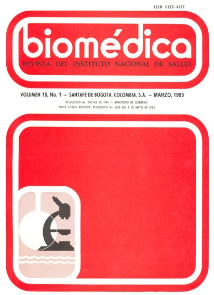Dermatomicosis en población de Manizales
Abstract
This is a report of the mycological study of 1,175 adult patients treate by Manizales medical cervices. It was possible to confirm a positive diagnosis in 779 patients (66,3%), with 72 (6,1%) occurrences of Pityriasis versicolor, 1 (0,1%) of Tinnea nigra palmaris, 291 (24,8%) of dermato-phyticcutaneous mycosisand 184 (15,7%) casesofcandidiasis. The frequency distribution includes 15 Microsporum, 101 Epidermophyton and 257 Tricophyton. The epidemiologic classification includes the following groups of fungi: antropophylic 357 (95,7%), geophytlic 10 (2,7%) and zoophylic 6 (1,6%). The most commonly found species were: M. canis, M. gypseum, E. floccosum, T. rubrum, T. mentagrophytes, T. tonsurans, T. verrucosum, Cladosporium werneckkii, and Malassezia furfur. This report describes the fungi isolated in dystrophic nails as follows: dermatophytes 82 (7,0%) and Candida albicans 103 (8,8%). In 46 (3,9%) patients nordermatophytes were cultured and incriminated as opportunistic pathogens according to several authors. In 10 (0,8%) samples, no etiological diagnosis was obtained because of the growth of Mycelia sterila. No growth ocurred in 386 (32,8%) cultures. This article presents an overview of the laboratory procedures and some general considerations concerning the pathology of dermatophytes.
Downloads
| Article metrics | |
|---|---|
| Abstract views | |
| Galley vies | |
| PDF Views | |
| HTML views | |
| Other views | |


























